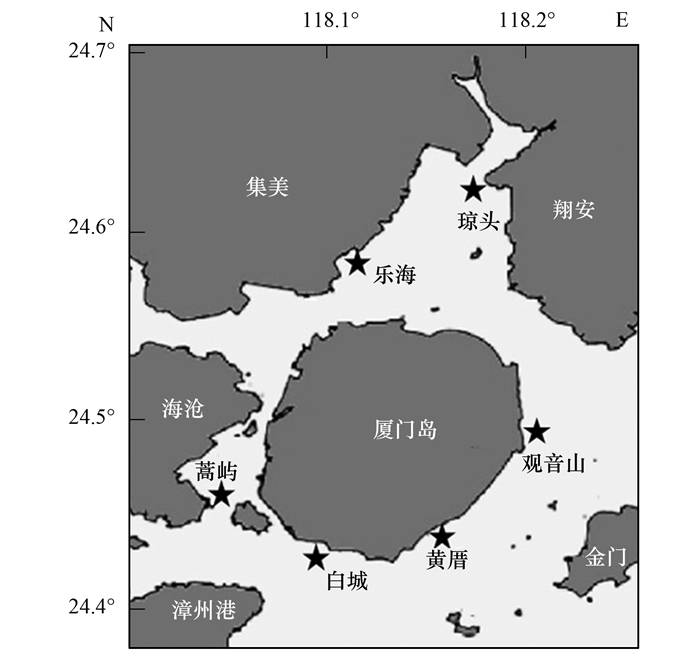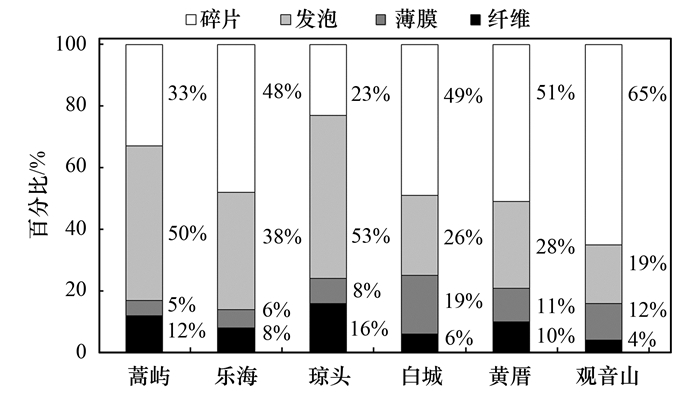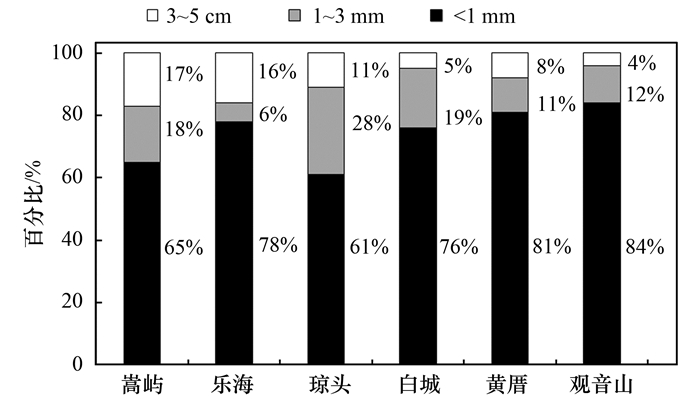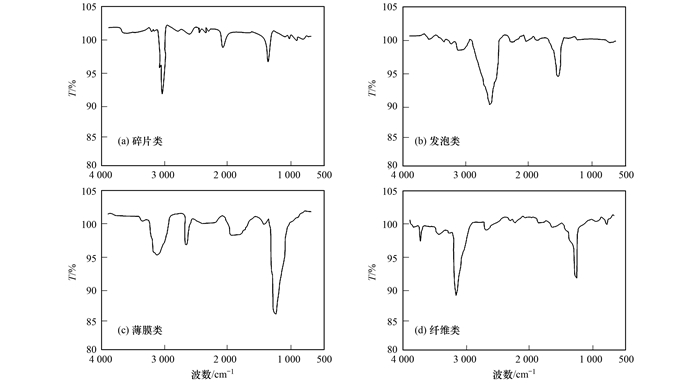2. 中国科学院城市环境研究所, 厦门 361021
2. Institute of Urban Environment, Chinese Academy of Sciences, Xiamen 361021, China
塑料具有优良的物理化学特性, 能广泛应用于工业、农业及日常生活中.使用后的塑料垃圾未被有效处理与处置后会以不同形态进入海洋.在机械作用、生物降解、光降解等过程的共同作用下, 海洋中的塑料垃圾会逐渐被分解成碎片, 并随海洋水动力过程进行迁移. 2018世界环境日主题为“塑战速决(beat plastic pollution)”, 塑料污染已是全球共同关注的热点环境问题之一.
微塑料(microplastics)一词由Thompson等[1]在2004年首次提出, 是指粒径从几微米到几毫米的非均匀塑料颗粒混合体的统称.学术界较常采用的上限阈值是5 mm.海岸带区域是人类社会经济活动最为活跃的地区, 更是海洋微塑料污染最为集中分布的区域.因此, 关于海洋微塑料污染的研究, 大部分集中在各沿海岸线地区[2~10].
厦门海域面积390 km2, 海岸线总长234 km, 是一个复式港湾.由于相对封闭, 海水交换周期长, 污染物扩散能力差、人类活动较为频繁等原因, 区域生态环境较为脆弱.在发展经济的同时如何保护环境, 尤其是如何应对新兴污染物——海洋微塑料问题, 是厦门湾生态环境保护中迫切需要开展的工作.本研究以厦门湾为工作区, 选择若干典型海滩, 从微塑料的丰度、类型、粒径、表面特征等角度, 综合分析微塑料的污染特征, 以期为半封闭海湾及海岸带区域的海洋微塑料污染防治和监管提供科学支持.
1 材料与方法 1.1 采样点位厦门由厦门本岛、集美、海沧、同安、翔安及众多小岛屿等组成, 位于福建省南部, 属亚热带气候, 年均气温21℃, 年均降雨量1 200 mm.陆地面积1 699 km2, 海域面积约390 km2.厦门湾为半封闭港湾, 包括厦门港、外港区、马銮湾、同安湾、九龙江河口区和东侧水道.本研究采样站位选择6个典型海滩:嵩屿、乐海、琼头、白城、黄厝和观音山(图 1).既包括厦门湾不同方位, 也包括外海及内湾.

|
黑色五角星表示采样点 图 1 厦门湾海滩采样站位 Fig. 1 Sampling sites of the beaches in Xiamen Bay, China |
利用低潮水位时段, 在海滩潮间带以S形选择5个样方大小为0.5 m×0.5 m正方形采样点, 用不锈钢铲采集约2~3 cm的表层样.采集的样品装入自封袋, 带回实验室阴凉干燥处自然风干.
微塑料分离采用较为常用的饱和氯化钠密度浮选分离法[11~14].具体步骤如下, 先将装有样品的烧杯放置在40℃的恒温水浴锅中, 加入已配制好的饱和氯化钠溶液(40℃, 1.36 g·cm-3), 用玻璃棒持续搅拌1~2 min, 静置5 min.然后将上清液用真空抽滤装置进行抽滤.抽滤后的滤膜放置表面皿中待进一步分析.
微塑料的丰度、分类及形状特征采用体视显微镜(B1-220, Motic公司)分析, 并经拍照后用Nano Measurer 1.2.5软件进行计数.微塑料的组成成分的确定采用傅里叶红外光谱仪(FT/IR480PLUS, JASCO公司)扫描分析.微塑料的微观表面特征采用扫描电镜(SEM, S-4800, Hitachi公司)观测.
1.3 数据处理本实验结果采用统计软件Excel 2007和SPSS19.0进行数据处理.
2 结果与分析 2.1 丰度本研究以5 mm为微塑料的上限阈值, 所采集样品中分离鉴定出的塑料小于5 mm的数量占塑料总数量的绝大部分(>96%), 普通大尺寸塑料仅占很小比例.区域微塑料污染程度的高低主要是通过丰度指标衡量.目前对微塑料丰度指标的参数常用“n·质量-1”方式表达(n为number, 即微塑料数量).经分析统计, 厦门湾6个海滩站位的微塑料丰度数据如表 1所示.琼头是微塑料丰度最大的海滩, 丰度为(312.7±35.2)n·kg-1.观音山是微塑料丰度最小的海滩, 丰度为(28.1±9.4)n·kg-1.其余4个海滩(嵩屿、乐海、白城、黄厝)的微塑料丰度介于(31.8±8.7)~(283.5±41.2) n·kg-1之间.
|
|
表 1 厦门湾海滩微塑料丰度/n·kg-1 Table 1 Abundance of microplastics on the beaches in Xiamen Bay/n·kg-1 |
2.2 类型
根据微塑料的形态差异, 本研究中将所检出的微塑料分为碎片类、发泡类、薄膜类和纤维类等4种类型.经分析统计, 厦门湾6个海滩站位不同类型微塑料数量比例如图 2所示.各海滩站位点的薄膜类和纤维类微塑料所占比例均不高, 分别为5%~19%和4%~16%之间, 碎片类和发泡类微塑料占总数量的80%左右.其中, 嵩屿和琼头以发泡类微塑料为主, 各占50%和53%;乐海、白城、黄厝和观音山以碎片类微塑料为主, 各占48%、49%、51%和65%.

|
图 2 厦门湾海滩不同类型微塑料数量比例 Fig. 2 Percentage of different microplastic types on the beaches in Xiamen Bay |
本研究中将所检出的微塑料粒径分为 < 1、1~3和3~5 mm这3个等级.经分析统计, 厦门湾6个海滩站位不同粒径微塑料数量比例如图 3所示.各海滩站位点粒径为1~3 mm和3~5 mm的微塑料所占比例不大, 分别为6%~28%和4%~17%之间.各海滩站位点粒径 < 1 mm的微塑料均占最大比例.其中, 观音山比例最高, 为84%;琼头比例最低, 为61%;嵩屿、乐海、白城和黄厝分别为65%、78%、76%和81%.

|
图 3 厦门湾海滩不同粒径微塑料数量比例 Fig. 3 Percentage of different particle sizes of microplastic on the beaches in Xiamen Bay |
对厦门湾各海滩检出的碎片类、发泡类、薄膜类和纤维类这4类微塑料进行红外光谱分析, 以确定各类型的微塑料组成成分.典型微塑料样品红外光谱如图 4所示.对比标准图谱及峰值数据, 确认碎片类和纤维类的主要成分是聚乙烯, 发泡类和薄膜类的主要成分是聚苯乙烯.

|
图 4 不同类型微塑料的红外光谱图 Fig. 4 FTIR spectrum of different microplastics samples |
微塑料的粒径上限阈值是5 mm.与同一类型大尺寸普通塑料[图 5(a)]比较, 微塑料在肉眼可视尺度上较为圆润均一[图 5(b)].但通过扫描电镜观测, 大部分微塑料表面粗糙、凹凸不平, 带有明显裂痕[图 6(a)].表面相对光滑, 裂痕和破损痕迹不太明显的比较少见[图 6(b)].

|
图 5 微塑料与普通大尺寸塑料对比 Fig. 5 Comparison between microplastics and larger plastic pieces |

|
图 6 微塑料扫描电镜图 Fig. 6 Scanning electron micrography (SEM) images of the microplastics |
厦门湾海滩微塑料分为碎片类、发泡类、薄膜类和纤维类这4种类型.经现场调查并参照相关研究, 大致可判断厦门湾各海滩不同类型微塑料的主要来源.碎片类微塑料来源最广, 各类工业、农业以及生活塑料废弃物裂解破碎后均可形成碎片类微塑料[2].发泡类微塑料主要来源于废弃的泡沫包装箱、简易门(墙)的泡沫隔温层和一次性泡沫餐具.另外, 厦门湾常见小渔船将大块泡沫绑于船底或船侧以增加浮力, 这些泡沫也是发泡类微塑料的重要来源之一.薄膜类微塑料主要来源于普通塑料类食品包装袋, 以及化肥袋、水泥袋等各类编织袋上的防水薄膜层[13, 15].纤维类微塑料主要来源于废弃的绳索或渔网.此外, 化纤类衣物碎裂掉落的细小纤维状残体也是纤维类微塑料的重要来源[16].
3.2 微塑料污染程度本研究中, 厦门湾6个海滩站位, 粒径 < 5 mm的微塑料丰度范围介于(28.1±9.4)~(312.7±35.2)n·kg-1之间.通过查阅国内外对沿海滩涂沉积物、沙滩土壤或海砂等的相关研究, 以同样的粒径 < 5 mm计数、计量单位为“n·kg-1”作为对比标准.巴西Boa Viagem(2 900 n·kg-1)[17]、意大利Venice(2175 n·kg-1)[18]、加拿大Halifax(2 000~8 000 n·kg-1)[19]、中国长江入海口[(3 420±1 310)]n·kg-1[20]等地的微塑料丰度较高.曹妃甸围填海区(634 n·kg-1)[21]等地的微塑料丰度处于中位程度.而比利时(120 n·kg-1)[22]、法国Nantes[(67±76) n·kg-1][23]、新加坡(12~63 n·kg-1)[24]等地的微塑料丰度相对较低.此外, 一项对欧洲沿海海滩沉积物的调查, 统计出13个国家共23个站位的微塑料丰度范围是(72±24)~(1 512±187)n·kg-1[25].综合比较, 厦门湾海滩微塑料污染处于中等偏下的程度.
3.3 各站位微塑料污染差异分析本研究中厦门湾6个海滩站位, 微塑料丰度大小依次为:琼头>嵩屿>乐海>白城>黄厝>观音山.从各站点所处位置考虑, 各类陆源垃圾的排放, 雨水冲刷、陆源排污口或河流的输入, 以及海流、潮汐的联合作用是造成微塑料地域分布差异的主要原因.琼头、嵩屿和乐海均处于厦门内湾, 水体交换程度低、污染物扩散能力差, 易于滞留污染物质.且琼头和嵩屿分别临近东西溪和九龙江入海口, 大量河流污染物对海滩微塑料有显著的贡献.而白城、黄厝和观音山则临近外海, 水域较为开阔.较为清洁的外海水体对海滩的不断冲刷, 使得海滩微塑料丰度相对较低.
从物质的迁徙赋存角度考虑, 微塑料有陆源和海源两大类.陆源包括直接丢弃在海滩的各类塑料垃圾, 以及通过雨水冲刷、陆源排污口或河流输入的塑料等.海源主要是在洋流和潮汐的作用下迁移并滞留在海滩上的各类海漂塑料垃圾.根据文献[26]的数据, 白城、黄厝和观音山所在的厦门岛南部近岸海域水体基本符合第一、第二类海水水质标准, 而琼头、嵩屿和乐海所在的厦门岛北部近岸海域水体水质较差, 部分甚至为劣四类海水.各站位海水水环境数据基本和海滩微塑料丰度大小较为一致.由此说明, 陆源污染是厦门湾海滩微塑料污染的最主要来源.
4 结论厦门湾海滩微塑料丰度数据范围介于(28.1±9.4)~(312.7±35.2)n·kg-1之间之间, 以粒径 < 1 mm的微塑料占最大比例.微塑料以碎片类和发泡类为主, 薄膜类和纤维类所占比例较少.碎片类和纤维类的主要成分是聚乙烯, 发泡类和薄膜类的主要成分是聚苯乙烯.大部分微塑料表面粗糙、凹凸不平, 带有明显裂痕.对比分析表明, 厦门湾海滩微塑料污染处于中等偏下的程度, 陆源污染是厦门湾海滩微塑料污染的最主要来源.
| [1] | Thompson R C, Olsen Y, Mitchell R P, et al. Lost at sea:where is all the plastic?[J]. Science, 2004, 304(5672): 838. DOI:10.1126/science.1094559 |
| [2] | Andrady A L. The plastic in microplastics:A review[J]. Marine Pollution Bulletin, 2017, 119(1): 12-22. DOI:10.1016/j.marpolbul.2017.01.082 |
| [3] | Auta H S, Emenike C U, Fauziah S H. Distribution and importance of microplastics in the marine environment:A review of the sources, fate, effects, and potential solutions[J]. Environment International, 2017, 102: 165-176. DOI:10.1016/j.envint.2017.02.013 |
| [4] | Bour A, Haarr A, Keiter S, et al. Environmentally relevant microplastic exposure affects sediment-dwelling bivalves[J]. Environmental Pollution, 2018, 236: 652-660. DOI:10.1016/j.envpol.2018.02.006 |
| [5] | Conkle J L, Báez Del Valle C D, Turner J W. Are we underestimating microplastic contamination in aquatic environments?[J]. Environmental Management, 2018, 61(1): 1-8. DOI:10.1007/s00267-017-0947-8 |
| [6] | Law K L, Thompson R C. Microplastics in the seas[J]. Science, 2014, 345(6193): 144-145. DOI:10.1126/science.1254065 |
| [7] | Zhang W, Ma X, Zhang Z, et al. Persistent organic pollutants carried on plastic resin pellets from two beaches in China[J]. Marine Pollution Bulletin, 2015, 99(1-2): 28-34. DOI:10.1016/j.marpolbul.2015.08.002 |
| [8] | Alimi O S, Budarz J F, Hernandez L M, et al. Microplastics and nanoplastics in aquatic environments:aggregation, deposition, and enhanced contaminant transport[J]. Environmental Science & Technology, 2018, 52(4): 1704-1724. |
| [9] | Yu X B, Ladewig S, Bao S W, et al. Occurrence and distribution of microplastics at selected coastal sites along the southeastern United States[J]. Science of the Total Environment, 2018, 613-614: 298-305. DOI:10.1016/j.scitotenv.2017.09.100 |
| [10] | Zhang H. Transport of microplastics in coastal seas[J]. Estuarine, Coastal and Shelf Science, 2017, 199: 74-86. DOI:10.1016/j.ecss.2017.09.032 |
| [11] | Nuelle M T, Dekiff J H, Remy D, et al. A new analytical approach for monitoring microplastics in marine sediments[J]. Environmental Pollution, 2014, 184: 161-169. DOI:10.1016/j.envpol.2013.07.027 |
| [12] | Cluzard M, Kazmiruk T N, Kazmiruk V D, et al. Intertidal concentrations of microplastics and their influence on ammonium cycling as related to the shellfish industry[J]. Archives of Environmental Contamination and Toxicology, 2015, 69(3): 310-319. DOI:10.1007/s00244-015-0156-5 |
| [13] |
简敏菲, 周隆胤, 余厚平, 等. 鄱阳湖-饶河入湖段湿地底泥中微塑料的分离及其表面形貌特征[J]. 环境科学学报, 2018, 38(2): 579-586. Jian M F, Zhou L Y, Yu H P, et al. Separation and microscopic study of microplastics from the sediments of the wetland in the estuary of Raohe River of Poyang Lake[J]. Acta Scientiae Circumstantiae, 2018, 38(2): 579-586. |
| [14] |
王昆, 林坤德, 袁东星. 环境样品中微塑料的分析方法研究进展[J]. 环境化学, 2017, 36(1): 27-36. Wang K, Lin K D, Yuan D X. Research progress on the analysis of microplastics in the environment[J]. Environmental Chemistry, 2017, 36(1): 27-36. |
| [15] | Free C M, Jensen O P, Mason S A, et al. High-levels of microplastic pollution in a large, remote, mountain lake[J]. Marine Pollution Bulletin, 2014, 85(1): 156-163. DOI:10.1016/j.marpolbul.2014.06.001 |
| [16] | Browne M A, Galloway T S, Thompson R C. Spatial patterns of plastic debris along Estuarine shorelines[J]. Environmental Science & Technology, 2010, 44(9): 3404-3409. |
| [17] | Costa M F, Do Sul J A I, Silva-Cavalcanti J S, et al. On the importance of size of plastic fragments and pellets on the strandline:a snapshot of a Brazilian beach[J]. Environmental Monitoring and Assessment, 2009, 168(1-4): 299-304. |
| [18] | Vianello A, Boldrin A, Guerriero P, et al. Microplastic particles in sediments of Lagoon of Venice, Italy:First observations on occurrence, spatial patterns and identification[J]. Estuarine, Coastal and Shelf Science, 2013, 130: 54-61. DOI:10.1016/j.ecss.2013.03.022 |
| [19] | Mathalon A, Hill P. Microplastic fibers in the intertidal ecosystem surrounding Halifax Harbor, Nova Scotia[J]. Marine Pollution Bulletin, 2014, 81(1): 69-79. DOI:10.1016/j.marpolbul.2014.02.018 |
| [20] |
朱晓桐, 衣俊, 强丽媛, 等. 长江口潮滩表层沉积物中微塑料的分布及沉降特点[J]. 环境科学, 2018, 39(5): 2067-2074. Zhu X T, Yi J, Qiang L Y, et al. Distribution and settlement of microplastics in the surface sediment of Yangtze Estuary[J]. Environmental Science, 2018, 39(5): 2067-2074. |
| [21] |
周倩, 章海波, 周阳, 等. 滨海潮滩土壤中微塑料的分离及其表面微观特征[J]. 科学通报, 2016, 61(14): 1604-1611. Zhou Q, Zhang H B, Zhou Y, et al. Separation of microplastics from a coastal soil and their surface microscopic features[J]. Chinese Science Bulletin, 2016, 61(14): 1604-1611. |
| [22] | Claessens M, De Meester S, Van Landuyt L, et al. Occurrence and distribution of microplastics in marine sediments along the Belgian coast[J]. Marine Pollution Bulletin, 2011, 62(10): 2199-2204. DOI:10.1016/j.marpolbul.2011.06.030 |
| [23] | Phuong N N, Poirier L, Lagarde F, et al. Microplastic abundance and characteristics in French Atlantic coastal sediments using a new extraction method[J]. Environmental Pollution, 2018, 243: 228-237. DOI:10.1016/j.envpol.2018.08.032 |
| [24] | Nor N H M, Obbard J P. Microplastics in Singapore's coastal mangrove ecosystems[J]. Marine Pollution Bulletin, 2014, 79(1-2): 278-283. DOI:10.1016/j.marpolbul.2013.11.025 |
| [25] | Lots F A E, Behrens P, Vijver M G, et al. A large-scale investigation of microplastic contamination:Abundance and characteristics of microplastics in European beach sediment[J]. Marine Pollution Bulletin, 2017, 123(1-2): 219-226. DOI:10.1016/j.marpolbul.2017.08.057 |
| [26] | 厦门市海洋与渔业局. 2017年厦门市海洋生态环境状况公报[R].厦门: 厦门市海洋与渔业局, 2018. |
 2019, Vol. 40
2019, Vol. 40

